Abstract
The stylet bundle of the sweet potato whitefly,Bemesia tabaci, consists of paired mandibles and maxillae. The latter interlock to form the food and salivary canals. Its salivary system consists of paired primary and accessary glands in the thorax. Primary and accessory gland ducts on each side of the nerve cord fuse to form lateral ducts that course anteroventrally to the midline and continue in parallel down the hypopharynx to eventually fuse to form the single afferent duct of the salivary pump. Saliva exiting the pump via the efferent duct enters the salivary canal of the maxillae. Food from the maxillary food canal passes from the antecibarium to the postcibarium or sucking pump and, per os, to the pharynx and esophagus of the foregut. The esophagus extends from the head to the base of the abdomen where it and the anterior midgut intimately mingle with the anterior hindgut to form a filter chamber. The midgut then proceeds dorsocaudally before looping anteroventrally to join the hindgut. The latter gives off two fingerlike Malpighian tubules before entering the filter chamber, whence it proceeds dorsocaudally to the anus within the vasiform orifice. Where possible, the morphology ofBemisia is discussed in relation to plant virus transmission and the morphologies of more thoroughly studied homopteran vectors such as aphids and leafhoppers.
Similar content being viewed by others
References
Ammar ED, Nault LR (1991) Maize chlorotic dwarf viruslike particles associated with the foregut in vector and nonvector leafhopper species. Phytopathology 81:444–448
Ammar ED, Jarlfors U, Pirone TP (1994) Association of potyvirus helper component protein with virions and the cuticule lining the maxillary food canal and foregut of an aphid vector. Phytopathology 84:1054–1060
Backus EA (1985) Anatomical and sensory mechanisms of leafhopper and planthopper feeding behavior. In: Nault LR, Rodriguez JG (eds) The leafhoppers and planthoppers. John Wiley, New York, pp 163–194
Berger PH, Pirone TP (1986) The effect of helper component on the uptake and localization of potyviruses inMyzus persicae. Virology 153:256–261
Childress SA, Harris KF (1989) Localization of virus-like particles in the foreguts of viruliferousGraminella nigrifrons leafhoppers carrying the semi-persistent maize chlorotic dwarf virus. J Gen Virol 70:247–251
Chudhry HS, Gupta PC (1970) Studies on the digestive system ofBemisia gossypiperda, M. & L (Homoptera, Aleyrodidae). The Entomologist 103:49–52
Cicero JM, Hiebert E, Webb SE (1994) Anatomy ofBemisia tabaci. In: Henneberry TJ, Toscano NC, Faust RM, Coppedge JR (eds) Silverleaf whitefly 1994 supplement to the five-year national research and action plan. USDA-ARS publication ARS125, p 42
Cicero JM, Hiebert E, Webb SE (1995) The alimentary canal ofBemisia tabaci andTrialeurodes abutilonea [sic] (Homoptera, Sternorrhynchi [sic]): histology, ultrastructure and correlations to function. Zoomorphology 115:31–39
Duffus JE (1987) Whitefly transmission of plant viruses. In: Harris KF (ed) Current topics in vector research, vol 2. Springer, New York, pp 73–91
Forbes AR (1964) The morphology, histology, and fine structure of the gut of the green peach aphid,Myzus persicae (Sulzer) (Homoptera: Aphididae. Mem Entomol Soc Can 36:1–74
Forbes AR (1977) The mouthparts and feeding mechanism of aphids. In: Harris KF, Maramorosch K (eds) Aphids as virus vectors. Academic Press, New York, pp 83–103
Harris KF (1977) An ingestion-egestion hypothesis of noncirculative virus transmission. In: Harris KF, Maramorosch K (eds) Aphids as virus vectors. Academic Press, New York, pp 165–220
Harris KF (1979) Leafhoppers and aphids as biological vectors: vector-virus relationships. In: Maramorosch K, Harris KF (eds) Leafhopper vectors and plant disease agents. Academic Press, New York, pp 217–308
Harris KF (1983) Sternorrhynchous vectors of plant viruses: virus-vector interactions and transmission mechanisms. Adv Virus Res 28:113–140
Harris KF (1990) Aphid transmission of plant viruses. In: Mandahar CL (ed) Plant viruses, vol II, pathology. CRC Press, Boca Raton, pp 177–204
Harris KF, Bath JE (1972) The fate of pea enation mosaic virus in its pea aphid vector,Acyrthosiphon pisum (Harris). Virology 50:778–790
Harris KF, Bath JE (1973) Regurgitation byMyzus persicae during membrane feeding: its likely function in transmission of nonpersistent plant viruses. Ann Entomol Soc Am 66:793–796
Harris KF, Childress SA (1981) Mechanism of maize chlorotic dwarf virus (MCDV) transmission by its leafhopper vector,Graminella nigrifrons. Abstr Ann Meet Am Soc Microbiol, Dallas, Texas: p 251
Harris KF, Bath JE, Thottappilly G, Hooper GR (1975) Fate of pea enation mosaic virus in PEMV-injected pea aphids. Virology 65:148–162
Harris KF, Treur B, Tsai J, Toler R (1981) Observations on leafhopper ingestion-egestion behavior: its likely role in the transmission of noncirculative viruses and other plant pathogens. J Econ Entomol 74:446–453
Harris KF, Pesic-Van Esbroeck Z, Duffus JE (1994) A morphological study ofBemisia organ systems of known importance in homopteran virus transmission (abstract). Phytoparasitica 22: 323–324
Harris KF, Pesic-Van Esbroeck Z, Duffus JE (1995a) Moderate-temperature polymerization of LR White in a nitrogen atmosphere. Microsc Res Technol 32:264–265
Harris KF, Pesic-Van Esbroeck Z, Duffus JE (1995b) Nitrogen as an infusion and polymerization medium for LR White embedding of whole small insects (abstract). Phytopathology 85:1180
Harris KF, Van-Esbroeck Z, Duffus JE (1995c) Vector anatomy of the sweet potato whitefly. Proceedings of the Eight International Confernce of Virus Diseases of Vegetables, Prague, Czech Republic. pp 49–52
Harris KF, Pesic-Van Esbroeck Z, Duffus JE (1996a) Morphological and cellular bases of virus transmission by whiteflies. Proc XX Int Congr Entomol (Florence, Italy), p 453
Harris KF, Pesic-Van Esbroeck Z, Duffus JE (1996b) Morphological bases for whitefly transmission of viruses. In: Henneberry TJ, Toscano NC, Faust RM, Coppedge JR (eds) Silverleaf whitefly 1996 supplement of the five-year national research and action plan. USDA-ARS publication, p 34
Harris KF, Pesic-Van Esbroeck Z, Duffus JE (1996c) Preparation of whole insects for combined light and electron microscopy and immunocytochemistry. In: Henneberry TJ, Toscano NC, Faust RM, Coppedge JR (eds) Silverleaf whitefly 1996 supplement of the five-year national research and action plan. USDA-ARS publication, p 35
Lim WL, Zoeten GA de, Hagedorn DJ (1977) Scanning electromicroscopic evidence for attachment of a nonpersistently transmitted virus to its vector’s stylets. Virology 79:121–128
Lopez-Abella D, Bradley RHE, Harris KF (1988) Correlation between stylet paths made during superficial probing and the ability of aphids to transmit nonpersistent viruses. In: Harris KF (ed) Advances in disease vector research, vol 5. Springer, New York, pp 251–285
Matsuda R (1965) Morphology and evolution of the insect head. Mem Am Entomol Inst 4:1–334
Pesic-Van Esbroeck Z, Harris KF, Duffus JE (1995a)Bemisia-geminivirus immunocytochemistry. Proceedings of the Eight International Conference on Virus Diseases of Vegetables, Prague, Czech Republic, pp 89–92
Pesic-Van Esbroeck Z, Harris KF, Duffus JE (1995b) Immunocytochemical localization of squash leaf curl virus (SLCV) in squash and the sweet potato whitefly (abstract). Phytopathology 85:1180
Pesic-Van Esbroeck Z, Harris KF, Duffus JE (1995c) Morphology of the whitefly feeding apparatus relative to noncirculative virus transmission (abstract). Phytopathology 85:1180
Pesic-Van Esbroeck Z, Harris KF, Duffus JE (1996) Sweet potato whitefly-squash leaf curl virus immunocytochemistry. In: Henneberry TJ, Toscano NC, Faust RM, Coppedge JR (eds) Silverleaf whitefly 1996 supplement of the five-year national research and action plan USDA-ARS publication, p 40
Ponsen MB (1972) The site of potato leafroll virus multiplication in its vector,Myzus persicae. Meded Labouwhogesch Wageningen 16–72, 147 pp
Ponsen MB (1977) Anatomy of an aphid vector:Myzus persicae. In: Harris KF, Maramorosch K (eds) Aphids as virus vectors. Academic Press, New York, pp 63–82
Prado E, Tjallingii WF (1994) Aphid activites during sieve element punctures. Entomol Exp Appl 72:157–165
Raine J, Forbes AR (1971) The salivary syringe of the leafhopperMacrosteles fascifron (Homoptera: Cicadellidae) and the occurrence of mycoplasma-like organisms in its ducts. Can Entomol 103:110–116
Rempel JG (1975) The evolution of the insect head: the endless dispute. Quaest Entomol 11:7–25
Snodgrass RE (1935) Principles of insect morphology. McGraw-Hill Books New York, 667 pp
Weber H (1928) Skelett, Muskulatur und Darm der schwarzen BlattlausAphis fabae Scop. mit besonderer Berücksichtigung der Funktion der Mundwerkzeuge und des Darms. Zoologica 28:1–120
Weber H (1935) Der Bau der Imago der Aleurodinen, ein Beitrag zur vergleichenden Morphologie des Insektenkörpers. Zoologica 33:1–71
Author information
Authors and Affiliations
Rights and permissions
About this article
Cite this article
Harris, K.F., Pesic-Van Esbroeck, Z. & Duffus, J.E. Morphology of the sweet potato whitefly,Bemisia tabaci (Homoptera, Aleyrodidae) relative to virus transmission. Zoomorphology 116, 143–156 (1996). https://doi.org/10.1007/BF02526946
Received:
Issue Date:
DOI: https://doi.org/10.1007/BF02526946




